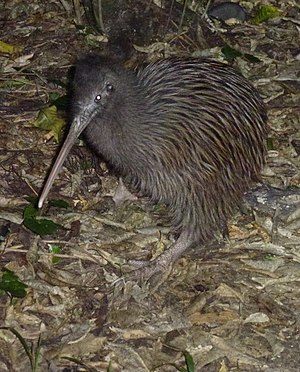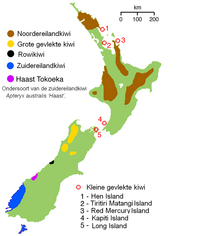Okaritokiwi
| Okaritokiwi | ||||||||||||
|---|---|---|---|---|---|---|---|---|---|---|---|---|

Okaritokiwi ( Apteryx rowi ) |
||||||||||||
| Systematics | ||||||||||||
|
||||||||||||
| Scientific name | ||||||||||||
| Apteryx rowi | ||||||||||||
| Tennyson , Palma , Robertson , Worthy & Gill , 2003 |
The Okaritokiwi ( Apteryx rowi ), also known as Rowi or Okarito-Striped Kiwi , is a species of ratite from the kiwi family . It was only split off from the southern striped kiwi ( Apteryx australis ) as an independent species in 2003 due to genetic studies . Its distribution area is the Ōkārito Forest , east and south of the Ōkārito Lagoon , on the west coast of New Zealand's South Island .
features
The okaritokiwi is about 55 cm tall. Males reach a weight of 1575 to 2250 g, females a weight of 1950 to 3570 g. The relatively short beak is 9.5 cm long in the males and 12.5 cm in length in the females. The plumage is predominantly brown with a slightly striped body. The feathers are blackish at the roots and at the edges. The distal feather sections are yellow-brown with dark yellow tips. The head, neck and stomach are distinctly gray. The wings have some transverse ligaments. Most of the specimens have a slight white fletching on the head, especially around the eyes. The iris is dark, the beak is pink. The vibrissae at the base of the beak are short. The legs and feet are pink or light brown. It differs from the southern striped kiwi mainly by a more gray head and belly, by the banded outer wing area and by a shorter pink (not cream or horn-colored) beak. The sexes are similar, with the males being lighter and more short-billed than the females. The juvenile birds are similar to the adult birds, but are smaller.
Vocalizations
The loud, shrill calls can be heard at night.
habitat
The Okaritokiwi prefers dense, temperate forests, especially the stone slabs - hardwood forests of the coastal region. He is a resident .
Eating behavior
No information is available on the food spectrum. Presumably he prefers foods similar to other kiwi species. He goes in search of food singly or in pairs. It is predominantly nocturnal, which is probably to be interpreted as a reaction to the presence of humans and predators.
Reproductive behavior
The breeding season extends from June to March. The okaritokiwi is monogamous and most couples form a lifelong bond. The nest is in a hidden cave previously dug by the birds themselves, or sometimes in a natural cavity on or very close to the ground. The nesting chamber is padded with soft material. If the eggs are laid repeatedly, another nesting site is sought. The female usually lays an egg. Occasionally there can be three eggs per season. The egg is white to greenish-white. Both parents brood. The chicks are independent immediately after hatching. The juvenile birds often remain in the family units for several years. Kiwis have a life expectancy of 80 to 100 years.
Danger
The Okaritokiwi is currently not registered by the IUCN . BirdLife International considers him a population of Streifenkiwis, in the category "endangered" ( vulnerable group). Its distribution is limited to a small area in and around the Okarito Forest on the west coast of New Zealand's South Island. In 2000 the population was estimated to be around 300 specimens. Thanks to nature conservation activities, this number rose to 375 in 2011 and to around 600 in 2018. The intensive monitoring of the population is coordinated nationally. The reenactment by kusus (Phalangeriformes) and ermines ( Mustela erminea ) as well as by stray dogs and cats is a serious endangerment problem, despite a program to eradicate the ermine. In 2010, three breeding pairs were released into the wild on Blumine Island , a 400-acre island in Queen Charlotte Sound on the northeast tip of the South Island that is free from predators. In addition, there is an incubation program at the West Coast Wildlife Center on Franz Josef Glacier , where eggs are taken from the Okarito Forest and hatched in the incubator. While the breeding success in the Okarito Forest is just 5 percent, it is over 90 percent for the fertile eggs incubated in human care. The juvenile birds are kept in enclosures until their nocturnal instincts are developed. They are then brought to Blumine until they are big enough to be able to defend themselves against predators. Only then do they return to Okarito. Studies of ancient DNA have shown that before humans arrived in New Zealand, the okaritokiwi had a much larger range, stretching from the west coast of the South Island to the southern half of the North Island. In 2000 the Okarito Kiwi Sanctuary was established, which covers an area of 11,000 hectares.
literature
- Tennyson, Alan JD; Palma, Ricardo L .; Robertson, Hugh A .; Worthy, Trevor H .; Gill, BJ, 2003: A new species of kiwi from Okarito, New Zealand . Records Of The Auckland Museum. 40: 55-64
- Matthew Backhouse: Survival of kiwi species depends on feisty young chick . In: The New Zealand Herald , July 7, 2013. Retrieved July 27, 2013.
- New Chick Signals Hope for Critically Endangered Kiwi . In: Kiwis for Kiwi , July 8, 2013. Accessed July 27, 2013.
Web links
- Brochure of the Rowi Project for the conservation of the Okaritokiwi
- Return of kiwi to North Island after hundreds of years of absence
- Huge rowi return marks a reversal in fortunes of rare kiwi species
- ARKive - Videos, Photos and Info on Apteryx rowi
Individual evidence
- ↑ Burbidge, ML, Colbourne, RM, Robertson, HA & Baker, AJ (2003): Molecular and other biological evidence supports the recognition of at least three species of brown kiwi. Conservation Genetics 4: 167-177.
- ↑ Laura Mills: Rare rowi kiwi to be released in Westland. December 13, 2018, accessed October 26, 2019 .
- ^ Robertson, HA (2004): Research and monitoring plan for the kiwi sanctuaries . Science for Conservation 241: 1-24.
- ↑ Kiwi released on Blumine Island . In: The Marlborough Express , June 30, 2010. Retrieved July 27, 2013.
